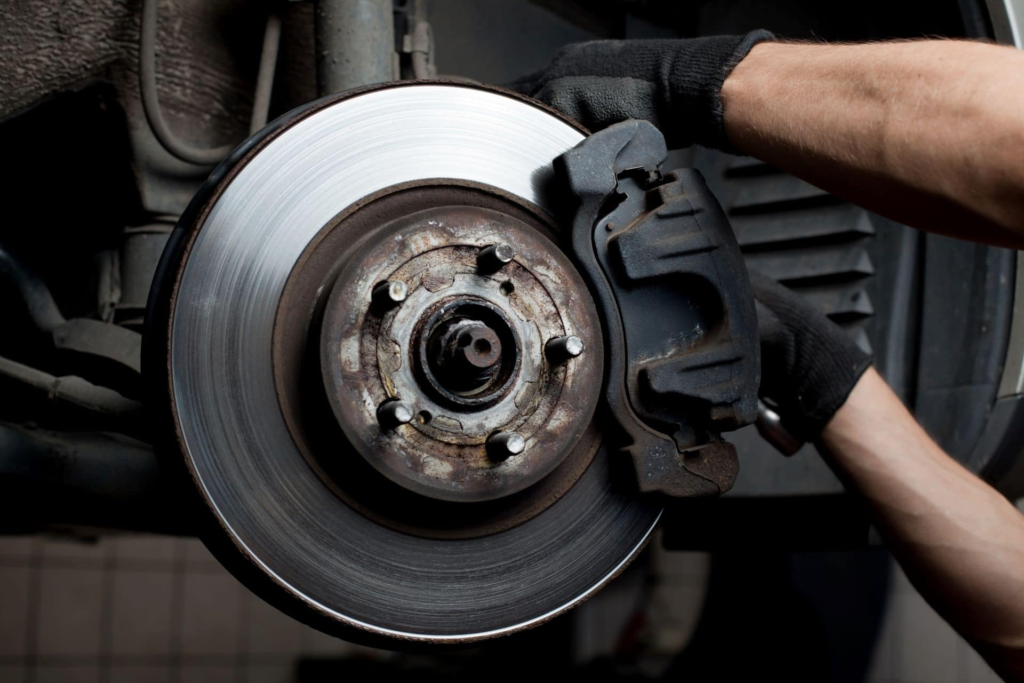
Brakes are arguably the most critical safety feature in any vehicle, responsible for slowing down and stopping effectively. Proper brake maintenance is crucial not only for your safety but also for the longevity and performance of your car. Understanding the basics of brake maintenance and knowing when to seek professional help can help ensure your brakes remain in optimal condition.

Routine Brake Inspection
Regular inspections are essential to identify potential brake issues early. Here are key components to inspect:
- Brake Pads and Shoes: Check the thickness of the brake pads (for disc brakes) or shoes (for drum brakes). Most brake pads have wear indicators that squeal when the pads are worn down to a certain level. If you hear squealing or grinding noises when braking, it’s likely time to replace the pads or shoes.
- Brake Rotors and Drums: Inspect the condition of the brake rotors (disc brakes) or drums (drum brakes). Look for signs of scoring, warping, or grooves on the surface. Rotors should be smooth and flat, while drums should have even wear. Excessive wear or damage may require resurfacing or replacement.
- Brake Fluid: Check the brake fluid level in the reservoir and inspect its condition. Brake fluid should be clear or slightly amber-colored. Dark or cloudy fluid indicates contamination and should be flushed and replaced according to manufacturer recommendations.
- Brake Lines and Hoses: Inspect brake lines and hoses for signs of leaks, corrosion, or damage. Leaking brake fluid can compromise brake performance and safety. Replace damaged or worn-out hoses promptly to prevent brake fluid leaks.
- Brake Calipers and Wheel Cylinders: Check brake calipers (disc brakes) or wheel cylinders (drum brakes) for leaks, corrosion, or sticking. Sticking calipers or cylinders can cause uneven brake wear and affect braking performance. Clean or replace as necessary.
Common Brake Problems
- Squealing or Grinding Noise: Squealing noises often indicate worn brake pads that require replacement. Grinding noises typically mean the brake pads are completely worn down, and metal is grinding against metal. Immediate replacement is necessary to prevent damage to other brake components.
- Soft or Spongy Brake Pedal: A soft or spongy brake pedal may indicate air in the brake lines or a brake fluid leak. It could also be a sign of worn brake pads or a malfunctioning master cylinder. Have the brake system inspected to identify and address the underlying cause.
- Vibration or Pulsation: Vibrations or pulsations felt through the brake pedal or steering wheel during braking may indicate warped brake rotors. Warped rotors can cause uneven braking and should be resurfaced or replaced to restore smooth braking performance.
- Brake Fluid Leaks: Visible brake fluid leaks under the vehicle or low brake fluid level in the reservoir indicate a leak in the brake system. Leaking brake fluid can compromise braking performance and should be addressed immediately by a professional mechanic.
Brake Maintenance Tips
- Follow Manufacturer Recommendations: Adhere to the manufacturer’s recommended maintenance schedule for brake inspections, fluid changes, and component replacements. Regular maintenance helps prevent premature wear and ensures reliable brake performance.
- Use Quality Brake Components: When replacing brake pads, rotors, or other components, choose high-quality parts that meet or exceed OEM specifications. Quality components ensure better performance, durability, and safety.
- Brake Fluid Flush: Regularly flush and replace brake fluid according to manufacturer recommendations to prevent moisture buildup and maintain optimal brake performance. Contaminated brake fluid can lead to corrosion and brake system failures.
- Professional Inspections: If you’re unsure about performing brake maintenance or repairs yourself, consult a professional mechanic or brake specialist. They have the expertise and tools to inspect, diagnose, and repair brake issues accurately.
Conclusion
In conclusion, maintaining your vehicle’s brakes is essential for safe driving and overall vehicle performance. By performing regular inspections, addressing common brake issues promptly, and following recommended maintenance practices, you can ensure your brakes operate effectively and reliably. Whether you’re checking brake pads for wear, inspecting brake fluid levels, or addressing brake noises or vibrations, proactive maintenance helps extend the life of your brake components and enhances driving safety. If you notice any signs of brake problems or if your brakes feel less responsive, don’t hesitate to seek professional assistance to diagnose and repair the issue promptly. Taking care of your brakes ensures a smoother, safer driving experience for you and your passengers.








